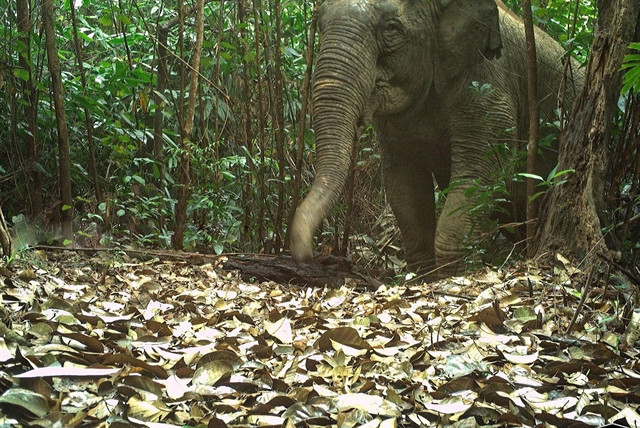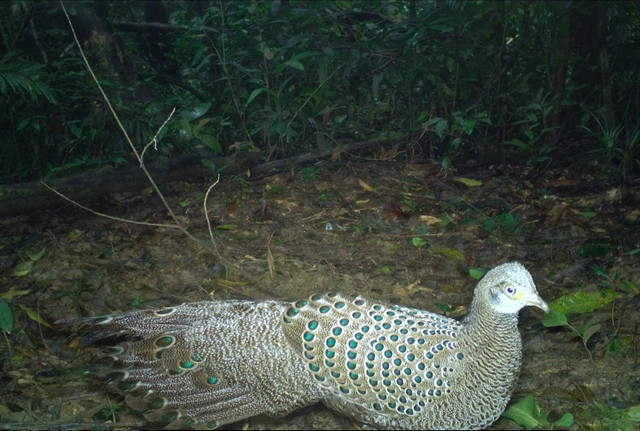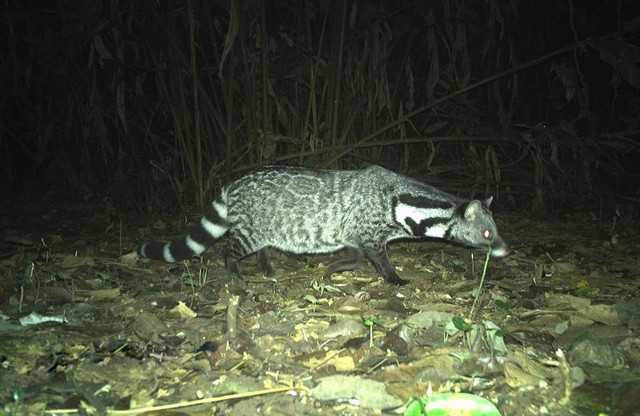 |
| An individual Asian elephant (Elephas maximus), captured by a camera trap, walks in the jungle of Vũ Quang National Park in the central Hà Tĩnh Province in 2023. Photos courtesy of USAID/WWF-Vietnam |
The results of the largest systematic camera trap survey ever conducted in Southeast Asia, with support from the United States Agency for International Development (USAID), were presented at the National Conference on Protected Areas.
The survey, carried out by USAID’s Biodiversity Conservation Activity, represents the most comprehensive and systematic biodiversity survey ever conducted in Việt Nam and builds on previous USAID-supported projects in the country to monitor biodiversity and forest cover. The survey confirms what has been widely suspected for many years – that populations of several key wildlife species have either disappeared or are in such low numbers as to be unviable as a result of widespread indiscriminate snaring.
“We are pleased to have partnered with MARD (the Ministry of Agriculture and Rural Development) and forest management boards to carry out one of the largest national biodiversity and threat baseline surveys ever in Việt Nam,” said USAID/Vietnam Deputy Mission Director Bradley Bessire.
“We hope that biodiversity monitoring results from this survey will be utilised to inform and improve overall protected area management and policy development in Việt Nam.”
Project partners set up 1,176 camera trap stations in 21 protected areas (PAs) across eight provinces, capturing more than 120,000 independent wildlife detections in millions of images during 2019-2023. Notable was the absence of large carnivores and herbivores, such as tigers, clouded leopards, Asiatic wild dogs, and the elusive saola – one of the few large mammals to be discovered in the world in the last 50 years. Asian elephants were detected in just two sites, and wild cattle species such as gaur only detected in one out of 21 sites surveyed. The most prevalent species recorded were those most resilient to hunting pressure, such as macaques, ferret badgers and wild pigs.
Although the survey revealed that wildlife has severely declined in all 21 PAs, there are still relatively high levels of species richness and endemism, with nine Annamite-endemic and 21 non-endemic but highly threatened species recorded. Rare species, such as the large-antlered muntjac and sun bear were also detected, providing some of the few records of these species in Việt Nam in the past 20 years,
A second survey is now underway across all the sites and will be compared to the baseline biodiversity survey when the USAID Biodiversity Conservation activity concludes in 2025, allowing the project to assess biodiversity trends in the 21 sites during its implementation period.
Director of the Forestry Department Trần Quang Bảo said: “We look forward to seeing the project's biodiversity survey results become more effective, supporting the Forestry Department to recommend appropriate policy to protect wildlife and conserve biodiversity.”
 |
| A grey peacock-pheasant (Polyplectron bicalcaratum) is recorded by a jungle camera trap in Phong Nha-Kẻ Bàng National Park in the central Quảng Bình Province. |
Despite species losses, there are positive signs that investment in threat reduction in a few sites in Central Việt Nam, including those previously supported by USAID, is resulting in stabilised or even increased populations of some species. This underscores the need to maintain investments in conservation efforts - including through the deployment of community patrol teams - in parallel with efforts to rewild Việt Nam’s protected areas.
Nick Cox, Chief of Party, USAID Biodiversity Conservation, implemented by WWF, stated: “For the first time we have the data to confirm Việt Nam’s wildlife populations are in dire straits. At the same time there are signs that investments by the Việt Nam Government, and by local and international NGOs, have had a positive impact. Now is the time to start a national conservation breeding programme to rewild the country’s protected areas, while protection efforts are sustained and increased, especially to reduce snaring.”
USAID Biodiversity Conservation Activity (BCA), being implemented from 2020 to June of 2025, aims to maintain and increase forest quality and protect and stabilise wildlife populations in high conservation value provinces, and targets 14 special-use forests (SUFs) and seven protection forests (PFs), linking forest management units across the landscape to maintain forest cover and connectivity of habitats vital for the protection of Việt Nam’s threatened and endemic species. BCA is implemented by WWF-US in collaboration with the project’s partners including WWF- Việt Nam, Helvetas, Leibniz Institute for Zoo and Wildlife Research, Re:wild, the International Union for the Conservation of Nature (IUCN), Education for Nature Vietnam (ENV), and Fauna & Flora.
 |
| A larger Indian Civet (Viverra zibetha) is caught in the lens of a camera trap in the forest of Cúc Phương National Park in the northern Ninh Bình Province in 2022. The species was listed as an Endangered Species. |
Last year, the USAID Biodiversity Conservation Activity launched a US$1.4 million Species Conservation Fund (SCF) in Việt Nam to support locally-led conservation efforts initiated by Vietnamese NGOs and other independent organisations.
SCF is a part of the $38 million USAID Biodiversity Conservation Activity and aims to strengthen biodiversity conservation in Việt Nam, especially through local organisations. Specifically, the SCF will support local NGOs and research organisations to conduct activities that contribute to conserving priority species of wildlife. The fund will provide awards from $20,000 to $50,000 for projects up to one and half year. VNS